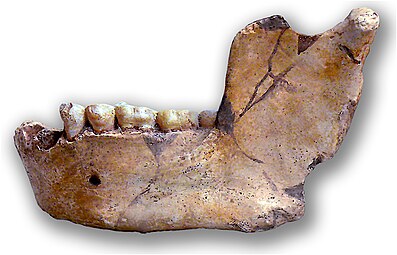Tighennif (formerly Ternifine) is a prehistoric site located near Mascara, in Orania (Algeria). It has yielded the oldest known human fossils in North Africa, dated to around 1 million years ago, along with an Acheulean lithic industry.
History

Camille Arambourg
From 1954 to 1956, French paleontologists Camille Arambourg and Robert Hoffstetter discovered several human fossils associated with an Acheulean lithic industry at the Tighennif site in the Mascara wilaya (Oran region), Algeria. The excavations were disrupted at the time by artesian water surges that regularly flooded the digs.
Thanks to the lowering of the water table, excavations could resume in 1982-83, leading to a dating study published in 1986 by Denis Geraads.
More recent excavations, restarted at the site in 2014 by Professor Mohamed Sahnouni, uncovered fossil animal bones and lithic tools dated to around 1 million years.
Description
The site consists of a former marsh or lake that was in an open and dry environment. The lake was fed by artesian springs that raised the underlying Miocene sand layer.
Fossil Remains
The site has yielded numerous animal bones and some human bones (3 mandibles, a parietal bone, and 9 isolated teeth), attributed in 1955 to a new species by Camille Arambourg: Homo mauritanicus (at the time, Atlanthropus mauritanicus).
The human fossils were dated to at least 700,000 years in 1986 by Denis Geraads through paleofaunal analysis, apparently corroborated at the time by paleomagnetism. In 2016, Denis Geraads revised the site’s dating to probably around 1 Ma, with the normal magnetic polarity at the site likely corresponding to the Jaramillo excursion (1.06 to 0.9 Ma BP).
The mandibles, very large in size, belonged to particularly robust humans. The ultimate attribution of these fossils to a specific species varies among authors.
 |  |
| Mandible Ternifine 3, lateral view | Complete view |
Lithic Industry
The site also yielded an Acheulean lithic industry featuring bifaces, cleavers, large retouched flakes, and small flint flakes, all of rather archaic craftsmanship, with rare use of soft hammer percussion and the Kombewa method, which better fits the site’s new dating.
Tighennif (formerly Ternifine) is a prehistoric site located near Mascara, in Orania (Algeria). It has yielded the oldest known human fossils in North Africa, dated to around 1 million years ago, along with an Acheulean lithic industry.
History

Camille Arambourg
From 1954 to 1956, French paleontologists Camille Arambourg and Robert Hoffstetter discovered several human fossils associated with an Acheulean lithic industry at the Tighennif site in the Mascara wilaya (Oran region), Algeria. The excavations were disrupted at the time by artesian water surges that regularly flooded the digs.
Thanks to the lowering of the water table, excavations could resume in 1982-83, leading to a dating study published in 1986 by Denis Geraads.
More recent excavations, restarted at the site in 2014 by Professor Mohamed Sahnouni, uncovered fossil animal bones and lithic tools dated to around 1 million years.
Description
The site consists of a former marsh or lake that was in an open and dry environment. The lake was fed by artesian springs that raised the underlying Miocene sand layer.
Fossil Remains
The site has yielded numerous animal bones and some human bones (3 mandibles, a parietal bone, and 9 isolated teeth), attributed in 1955 to a new species by Camille Arambourg: Homo mauritanicus (at the time, Atlanthropus mauritanicus).
The human fossils were dated to at least 700,000 years in 1986 by Denis Geraads through paleofaunal analysis, apparently corroborated at the time by paleomagnetism. In 2016, Denis Geraads revised the site’s dating to probably around 1 Ma, with the normal magnetic polarity at the site likely corresponding to the Jaramillo excursion (1.06 to 0.9 Ma BP).
The mandibles, very large in size, belonged to particularly robust humans. The ultimate attribution of these fossils to a specific species varies among authors.
 |  |
| Mandible Ternifine 3, lateral view | Complete view |
Lithic Industry
The site also yielded an Acheulean lithic industry featuring bifaces, cleavers, large retouched flakes, and small flint flakes, all of rather archaic craftsmanship, with rare use of soft hammer percussion and the Kombewa method, which better fits the site’s new dating.








